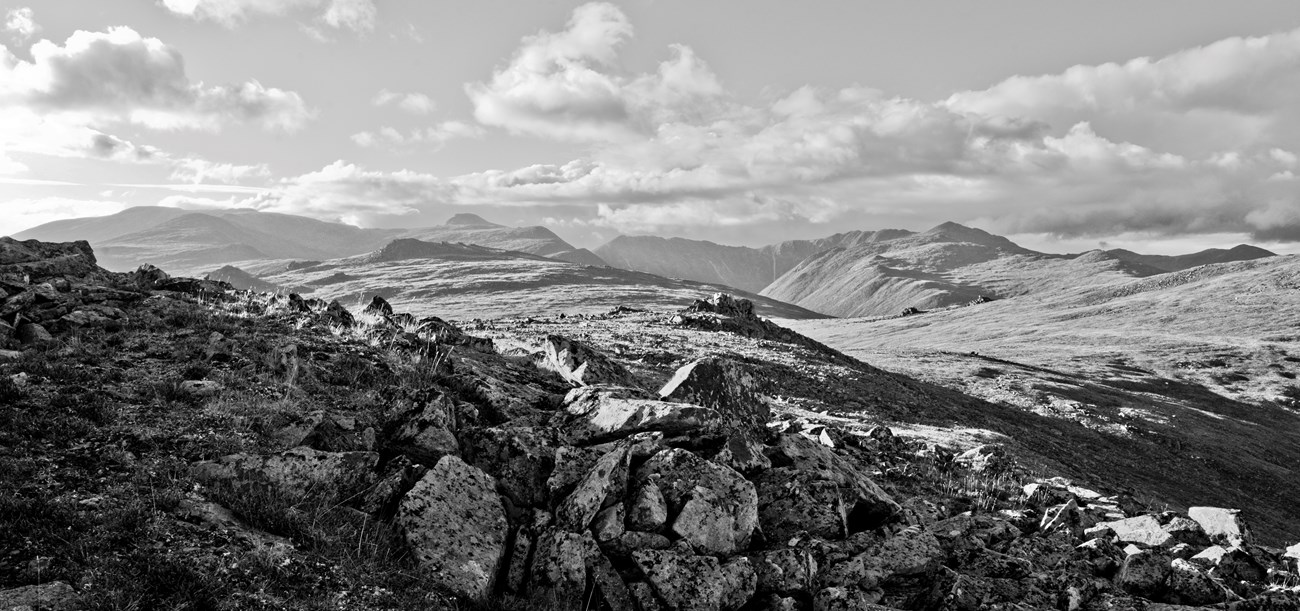|
Visit our keyboard shortcuts docs for details
A journey on these rivers passes through an ancient landscape. The shallow crystal-clear waters of the Charley meet the mighty silt-laden Yukon. Stunning cliffs and rock formations rise above the river basins, home to the Han Athabascan people. Aspiring miners came here in the 1898 Gold Rush, leaving behind ghost towns and dreams. Peregrine falcons nest in the high bluffs overlooking the rivers. Visitors float the rivers for the solitude and for glimpses of historic sites left after the gold rush er 
NPS / Josh Spice Deep in Interior Alaska, the great Yukon River strikes through bluffs and mountains of an ancient landscape to unmask rocks whose histories reach back a billion years to life's beginnings on Earth. Axis of the region, the silt-laden Yukon here flows constricted and swift through a great geologic fault. Side-streams tumble from the hinterlands - further passageways long inviting human traffic. Chief among these crystal rivers are the Charley, Kandik, and Nation. Flowing first through upland valley, then through stream-cut valley, and finally onto mature flood-plain, the Charley River offers spectacular unspoiled wilderness scenery. 
NPS / Josh Spice The preserve lies between the communities of Eagle and Circle, Alaska. New Jersey with its 7.5 million residents would fit between these towns, but there are only 20 year-round residents here. Truly isolated, the preserve is wilder and less populated now than it was 50 or 80 years ago. The late-1800s Klondike and Nome gold rushes turned Circle - 2000 population 100 - into the Paris of the North, boasting an opera house. Pokes of gold were legal tender. This was the stuff of Jack London's stories and Robert Service's poetry. Eagle's population - about 130 in 2000 - was 800. Fort Egbert had electric lights and hot-and-cold running water.
Circle and Eagle were south-bank trade centers on the great Yukon River thoroughfare that bisects Alaska east to west for 1,250 river miles and stretches for 1,979 river miles from its headwaters near Whitehorse, in Canada's Yukon Territory, to its mouth at the Bering Sea. When not choked with stupendous, lethal spring and fall ice floes, the Yukon serves as summer waterway or frozen winter highway. Ancient hunters had traveled through the unglaciated Yukon corridor. Those who stayed probed the uplands for game via the stream-carved valleys. Forays upland took them first through thickets of willow and alder, through stands of white spruce and cottonwood screening the rivers, then across boggy flats punctuated by stunted black spruce. mixed white spruce, birch, and aspen gave way to brush as the hunters climbed toward dry tundra on the ridges. Above them loomed always the barren mountains scored by scree slopes and topped by granite pinnacles. 
NPS / Josh Spice What scientists think may be remnant Ice Age vegetation occurs as patches of arctic steppe on sun-drenched benches and bluffs. Now, winter's darkness and cold conspire to isolate this land abutting the Arctic Circle. Animals go to ground or migrate, or, like the mountain sheep, stand hunched against arctic winds. Rivers and streams freeze over. Deprived of silt from these frozen sources, the winter Yukon runs clear under as much as 6 feet of ice.
But the sun returns. The rivers break. Bird calls herald spring. Peregrine falcons refurbish old cliff eyries, and the swift flight and stoop of these winged hunters take their toll on migrating birds. Salmon begin their runs, first the big kings and then the dog salmon. Here, 1,200 miles from the sea but with many miles left to swim, the powerful fish are still firm of flesh. And as they have for centuries, people gather at fish camps along the Yukon.
People who stayed after the glory days of gold faded - Han Indians already home and recent arrivals who had found a home - settled back into a slower pace, trapping, hunting, fishing, gardening. With easily exploited placer deposits of gold exhausted, mining, too, changed from a rush to long toil. Even today along the Yukon a fish camp may lie just around the bend - fishwheel or net in the water, fish drying on stream-side racks. Hunters track moose and caribou, and trappers test their mettle against the unforgiving land.
Life, in all its flintiness, persists here as it has for ages, and a few hardy souls still pit their fortunes against a true frontier wilderness.
Visit our Significance page to learn what makes Yukon-Charley Rivers unique and why it's protected.
|
Last updated: September 9, 2025
